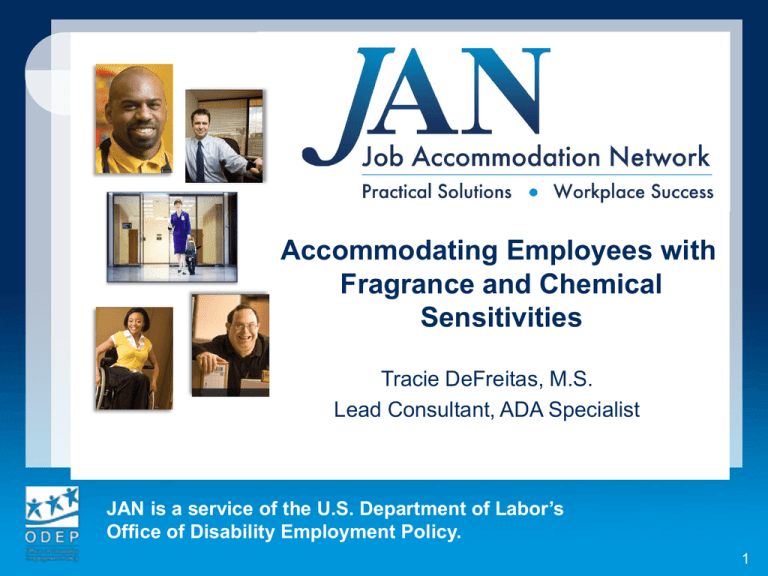Fragrance Sensitivity - Job Accommodation Network
advertisement

Accommodating Employees with Fragrance and Chemical Sensitivities Tracie DeFreitas, M.S. Lead Consultant, ADA Specialist JAN is a service of the U.S. Department of Labor’s Office of Disability Employment Policy. 1 Overview Defining Fragrance/Chemical Sensitivity Working Through the Interactive Process Common Workplace Issues & Accommodation Solutions Fragrance Sensitivity, the ADA, & Policies 2 Fragrance/Chemical Sensitivity Defined Inability to tolerate an environmental chemical or class of chemicals Intolerance to even very low level exposure to chemicals Symptoms occur in more than one organ system Problem is ongoing Same symptoms are reproducible with repeated exposure to the triggers Avoidance is key 3 Triggers, Symptoms, and Limitations Triggers Fragrances (variety) Air fresheners/deodorizers Tobacco Smoke Cleaning agents New carpet/furnishings Floor wax/stripper Paint Pesticides Poor indoor air quality (IAQ) Symptoms & Limitations Difficulty breathing Tightening of the throat Headaches/migraines Nausea Difficulty concentrating/memory loss Fatigue Dizziness Skin irritation/hives Arthritis-like sensations and muscle pain 4 Fragrance in the Workplace Prevalence of fragrance sensitivity in the American population (Caress SM, Steinemann AC, J Environmental Health, 2009) 30.5% of the general population reported scented products on others to be irritating Considerable percentage of the U.S. population reports adverse health effects or irritation from fragranced products, with higher percentages among those with asthma and chemical sensitivity JAN cases Causative Factor of Fragrance Sensitivity Approximately 850 Contacts, 2/09-2/14 Accommodations, Policy Language, ADA 5 Interactive Process Work Collaboratively to Identify a Solution Fragrance/Chemical Sensitivity At Work What limitations is the employee experiencing? How are these limitations affecting job performance? What accommodations are available? 6 Disability and the ADAAA An individual has a disability under the ADA Amendments Act if he or she: has a physical or mental impairment which substantially limits one or more major life activities; has a record of such an impairment; or is regarded as having Substantially limited is construed broadly Compared to most people in the general population Ultimately, employer decides Not sure? Err on the side of caution and process the request such an impairment. 7 Example An employee was having difficulty working in open spaces with co-workers whose scented products made her ill. She asked not to have to attend face-to-face meetings in the office and to attend a week-long training remotely. Is this a request for accommodation? What limitations is the employee experiencing and is medical information needed? How are these limitations affecting job performance? Has the employee suggested accommodations? What about the medical provider or other resources, like JAN? What accommodation solutions are reasonable and effective? 8 Solutions On-site Meetings Training Advance notice of meetings Attend training remotely Fragrance-free policy for meetings Advance access to training materials Attend meetings remotely Alternative training method (e.g., with a supervisor or one-onone trainer) Provide handouts in advance and minutes after Mask, air cleaner, alternate location Fragrance-free policy for trainings Mask 9 Common Workplace Issues Poor Indoor Air Quality (IAQ) Construction and Remodeling Cleaning Products and Deodorizers Exposure to Fragrances JAN’s Employees with Fragrance Sensitivity JAN’s Employees with Multiple Chemical Sensitivity or Environmental Illness 10 Poor Indoor Air Quality (IAQ) Conduct air quality testing (industrial hygiene professional) Control or eliminate pollutants Allow alternative work arrangements Add or remove plants Do not allow burning of candles, etc. Replace/clean filters Provide a room air cleaner Provide a mask or personal air cleaner Maintain a clean, dry work environment 11 Products/Protection Desktop Air Cleaner “I Can Breathe” Mask JAN does not recommend or endorse products. Personal Air Cleaner R95 Carbon Mask 12 Construction and Remodeling Offer pre-notification Allow alternative work arrangements Schedule remodeling activities when building is not occupied Use non-toxic or green building materials, furnishings, and supplies (low/no VOC) Provide a mask Allow time for offgassing of new products Provide air cleaning system Use non-toxic carpeting or alternative floor covering (tile, cork, wool, SafeChoice Carpet Seal) Relocation or reassignment 13 Cleaning Chemicals and Deodorizers Ask the employee for suggestions. What do you use at home? Discontinue using spray deodorizers, scented candles, scent dispensers, etc., and opt for non-scented odor neutralizers Allow time for offgassing of products Provide air cleaning systems suitable for fumes and increase air flow/air exchanges per room Provide a mask Use non-toxic or natural cleaning products (baking soda, Borax, vinegar, etc.) JAN does not recommend or endorse products. 14 What’s the most common sensitivity JAN Consultants hear about? 15 Fragrance Sensitivity Perfumes, colognes, scented lotions, detergents, personal care products, air fresheners, candles, etc. Provide an air cleaner, mask, fan Remove the offending fragrance Allow alternative work arrangements Move the employee from the source of the fragrance Do not require attendance at social events Provide an enclosed workspace Reduce exposure to fragrances by implementing a policy Allow to attend meetings remotely 16 Example A healthcare worker requested that the employer guarantee a 100% fragrance free environment as an accommodation. Is an employer required to implement a fragrance policy as a reasonable accommodation? Is a fragrance policy a reasonable accommodation? 17 Fragrance Sensitivity & the ADA Roberts v. Slater (EEOC 2000) Employee with chemical sensitivity asked employer, the Department of Transportation, for a fragrance-free environment An entirely fragrant free environment was not a reasonable request for accommodation, and would have imposed an undue hardship on the agency’s operation While implementing a fragrance policy may not be a reasonable accommodation under the ADA, employers are not precluded from doing so, or sending out memos to make people aware of the concept of being courteous to fellow co-workers. (EEOC) 18 Fragrance Sensitivity & the ADA McBride v. City of Detroit (E.D. Mich. 2008) Court held that while a "scent-free" policy for the workplace is indeed an unreasonable accommodation because it would require an undue hardship, the evidence indicated that employee was not actually seeking a "scent-free" policy per se—the employee wanted to work with management to come up with something that would provide her relief Employer’s inaction and statements of its human resources personnel suggested that there was no interactive process City of Detroit settled in 2010, paid McBride, a senior city planner, $100,000, and changed its ADA handbook and training, and posted notices about their fragrance policy 19 Fragrance Sensitivity & the ADA Core v. Champaign County. Board of County Commissioners, (S.D. Ohio 2012) Employee with severe asthma and chemical sensitivity to certain perfumes and other scents Co-workers mocked her, including in Facebook posts making fun of her condition. Alleged that employees began to wear a particular perfume intentionally around her and that the employer took no action to stop this conduct Request for an official policy banning all fragrances might be reasonable, particularly in light of the objectionable conduct engaged in by co-workers and the allegation that the employer took no steps to stop the conduct 20 Example The employer purchased an air purifier, asked certain employees who wore heavy scents to refrain from doing so, and placed posters around the office to educate all employees about fragrance sensitivity. The employee was also moved to a larger room where she was not so confined. In JAN’s follow-up survey, the employer reported that by making accommodations for this employee they also raised company awareness on fragrance sensitivity throughout its 25 offices. 21 Fragrance Policy Issues May not be ‘reasonable’ within the meaning of the ADA, but employer is not precluded from doing more 100% fragrance-free may not be feasible, but can limit exposure Increase awareness and do not tolerate harassment Can benefit all employees/visitors/patients 22 Developing a Fragrance Policy Conduct an employee needs assessment Conduct a workplace and personal chemical assessment Understand applicable local, state, federal statutes Include employee representation in all phases of the development, implementation, and evaluation 23 Developing a Fragrance Policy Ensure all departments understand their role in the success of policy implementation Regularly evaluate the policy for effectiveness and make changes as needed Develop a disciplinary process prior to implementation Develop strategies for communicating the policy to “outsiders” 24 Fragrance Policy Example American Lung Association Policies 1. [EMPLOYER] expects that all offices and spaces used by the staff and their visitors remain free of scented products. 2. Personal care products such as cologne, perfume, aftershave lotions, scented lotions, fragranced hair products and/or similar products are not to be worn in the facilities owned and operated by [EMPLOYER] including company owned vehicles. 3. Use of air fresheners and candles are prohibited from the facilities owned and operated by [EMPLOYER] including company owned vehicles. 4. Use of cleaning products other than those purchased by the [EMPLOYER or BUILDING MANAGEMENT] are prohibited for cleaning personal workspaces. 25 Fragrance Policy Example American Lung Association Procedure 1. Employees will be informed of the [EMPLOYER] Fragrance-free Policy through signs posted throughout properties owned and operated by [EMPLOYER] including company-owned vehicles. 2. Visitors will be informed of the [EMPLOYER] Fragrance-free Policy by their hosts, the meeting invite, email correspondences and signs posted throughout the properties owned and operated by [EMPLOYER]. Sample Email Signature for guests: “This is a fragrance-free workplace. Thank you for not wearing any of the following during your visit: cologne, after shave lotion, perfume, perfumed hand lotion, fragranced hair products, and/or similar products. Our chemically-sensitive co-workers and clients thank you.” 3. Any violations of this policy will be handled through the standard disciplinary procedure. 26 Fragrance Policy Example Society for Human Resource Management “Recognizing that employees and visitors to our offices may have sensitivity and/or allergic reactions to various fragrant products, [Company Name] is a fragrance-free workplace. Personal fragrant products (fragrances, colognes, lotions, powders and other similar products) that are perceptible to others should not be worn by employees. Other fragrant products (scented candles, potpourri and other similar items) are also not permitted in the workplace. Any employee with a concern about scents or odors should contact his or her manager or the Human Resource Department.” 27 Fragrance Policy Example U.S. Centers for Disease Control “Scented or fragranced products are prohibited at all times in all interior space owned, rented, or leased by CDC this includes the use of: Incense, candles, or reed diffusers. Fragrance-emitting devices of any kind Wall-mounted devices, similar to fragrance-emitting devices, that operate automatically or by pushing a button to dispense deodorizers or disinfectants. Potpourri Plug-in or spray air fresheners Urinal or toilet blocks Other fragranced deodorizer/re-odorizer products Personal care products (e.g. colognes, perfumes, essential oils, scented skin and hair products) should not be applied at or near actual workstations, restrooms, or anywhere in CDC owned or leased buildings.” 28 Fragrance Policy Example Brant Community Healthcare System “In our efforts to provide a healthier place of work and care the BCHS promotes a fragrance free environment to minimize the potential adverse allergic and/or medical reactions that can occur among patients, visitors, staff, and volunteers such as asthma, allergies, respiratory conditions and migraine headaches. Wearing or using products with a noticeable scent such as perfume, colognes, aftershave, and body spray, perfume, cologne, aftershave, some air fresheners and cleaning products is not permitted within this facility.” 29 Fragrance Policy Example U.S. Access Board “…the Board requests that all participants refrain from wearing perfume, cologne and other fragrances, and use unscented personal care products in order to promote a fragrance-free environment. This request is included in notices and on displayed signage for the Board’s meetings, hearings, and other public events. In addition, the Board will work with the operators of meeting sites to prevent the use of deodorizers and cleaning products immediately before the event in and around meeting locations.” 30 Fragrance Poster Examples 31 Accommodation Example A state employer had received requests from employees with fragrance sensitivity who worked in various positions. The employer was looking for general accommodation ideas. After contacting JAN, the employer reported that it was in the process of determining the best way to have a fragrance-free workplace, given that it is a public agency and employees work in cubicles rather than private offices. They were also looking into restricting employees from wearing strong fragrances and providing masks for employees who would like to wear them. 32 Accommodation Example A local government employee requested accommodations due to fragrance sensitivity. The employer purchased an air purifier, custodians were instructed to use non-scented janitorial products, and areas of a public facility were designated as non-scented/fragrance-free zones. The employer educated all employees on refraining from wearing fragrances on the job. The employee was also permitted to work from home one day per week. Reported cost: $1,000 33 Accommodation Example A police officer experienced migraines that were triggered by fragrances. The employer allowed the employee to work a modified schedule and assigned her to low volume areas where she would be less likely to come into contact with individuals wearing fragrances. 34 JAN Resources Interactive Process Medical Inquiry in Response to an Accommodation Request How to Determine Whether a Person Has a Disability Under the ADAAA Accommodation and Compliance Series: The ADA Amendments Act of 2008 Employees with Fragrance Sensitivity Employees with Multiple Chemical Sensitivity or Environmental Illness 35 Thank you for participating! Contact (800)526-7234 (V) & (877)781-9403 (TTY) AskJAN.org & jan@askjan.org (304)216-8189 via Text janconsultants via Skype 36









